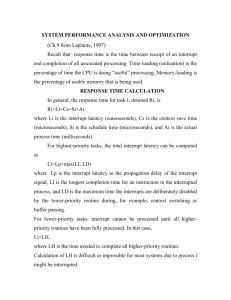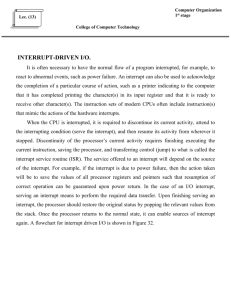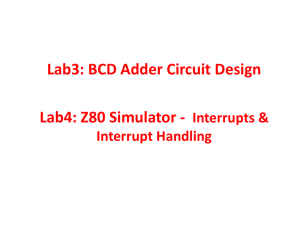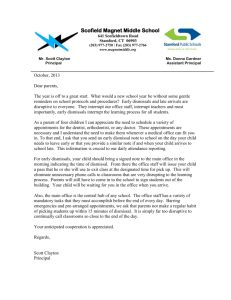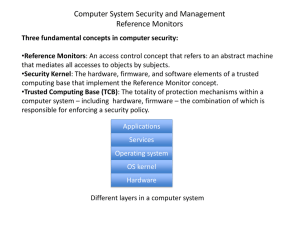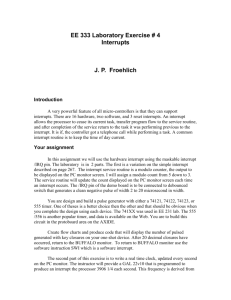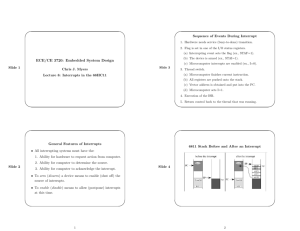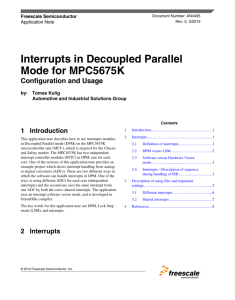Case study: evaluating the e ect of email interruptions within the
advertisement
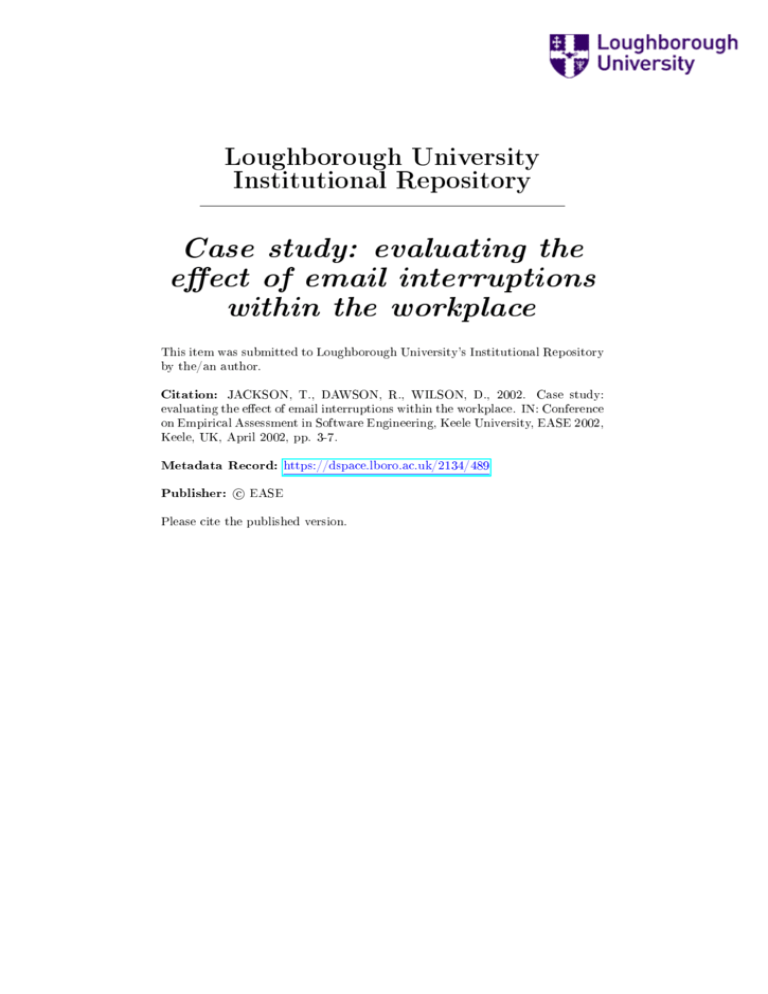
Loughborough University Institutional Repository Case study: evaluating the eect of email interruptions within the workplace This item was submitted to Loughborough University's Institutional Repository by the/an author. JACKSON, T., DAWSON, R., WILSON, D., 2002. Case study: evaluating the eect of email interruptions within the workplace. IN: Conference on Empirical Assessment in Software Engineering, Keele University, EASE 2002, Keele, UK, April 2002, pp. 3-7. Citation: Metadata Record: Publisher: https://dspace.lboro.ac.uk/2134/489 c EASE Please cite the published version. This item was submitted to Loughborough’s Institutional Repository by the author and is made available under the following Creative Commons Licence conditions. For the full text of this licence, please go to: http://creativecommons.org/licenses/by-nc-nd/2.5/ Case Study: Evaluating the Effect of Email Interruptions within the Workplace Thomas Jackson1,2, Ray Dawson2 and Darren Wilson 1 1 2 Danwood Group, Lincoln, UK Loughborough University, Leics., UK – (t.w.jackson@lboro.ac.uk) Abstract This experience report outlines the value of measuring the communication processes through electronic monitoring and is a follow up to the paper presented at the EASE 2001 conference last year. The use of email by employees at the Danwood Group was studied and it was found that the interrupt effect from emails was non-trivial. The common reaction to the arrival of an email is to react almost as quickly as responding to telephone calls. This means the interrupt effect is comparable with that of a telephone call. The recovery time from an email interruption was found to be significantly less than the published recovery time for telephone calls. It is to be concluded, therefore, that while email is still less disruptive than the telephone, the way the majority of users handle their incoming email has been shown to give far more interruption than expected. Through analysing the data captured, the authors have been able to create a set of recommended guidelines for email usage. The guidelines will increase employee efficiency by reducing the prominence of interruptions, restricting the use of email-to-all messages, setting up the email application to display three lines of the email and to check for email less frequently. It is recommended that training should be given to staff on how to use email more effectively to increase employee effectiveness. Introduction Electronic communication is becoming an integral part of the communication structure within organisations, but the costs and benefits are not being assessed. Communication by email is usually assumed to be an efficient and effective means of sending messages. However, on analysis the process is seen to be much more complex and much less efficient than is normally assumed. Communication is carried out in many different forms, but the common underlying motive of communication is to improve working practices and to increase productivity. As communication pervades nearly everything we do, even small improvements in the effectiveness and cost of our communication processes can have significant benefits. The aim of this research was to analyse the cost effectiveness of using email and to suggest ways in which the cost effectiveness can be improved. This experience report resulted from a study conducted into the cost effectiveness of email within organisations and reports the next stage of the research reported at EASE 2001(Jackson & Dawson, 2001). The studies were carried out mainly at the Danwood Group, the company sponsoring the author’s research. The Danwood Group has just over 500 employees at 19 sites around the UK and its head office is based in Lincoln. The Danwood Group retails office equipment, predominately photocopiers and has an annual turnover of 35 million pounds. This paper reports further analysis of how employees use email and, in particular, how many employees could improve their effectiveness with more appropriate use of the email facility. The investigation of the effects of email interruptions on the workplace forms a study within the company to establish the value of such analysis. The company expects that a basic understanding gained from this study will provide the data for communication planning and corrective actions for the problems uncovered. The paper concludes with a set of guidelines to improve employee effectiveness with better use of email. Research carried out by Solingen into communication interrupts showed 15-20 percent of an employee’s effort is spent dealing with interrupts and in real terms 15-20 minutes per interrupt (Solingen R., Berghout E. and Latum F. September/October 1998). An interrupt is defined as “any distraction that makes a developer stop his planned activity to respond to the interrupt’s initiator”. There were three types of interrupts defined: personal visits, telephone calls and emails. Personal visits and telephone calls caused 90 percent of all interrupts and email caused the rest. The results showed the effort spent on interrupts required approximately 20 minutes for each occurrence, including the time spent handling the interrupt, and that the average developer receives three to five interrupts per day. This consumes roughly 1 to 1.5 hours per day of the developer’s time. DeMarco reported that the recovery time after a phone call interruption is at least 15 minutes, thus increasing the amount of time spent on interrupts a day (DeMarco T. and Lister T. 1987). However, DeMarco’s research was carried out using software developers as the subjects. The highly creative nature of a software developer’s job means they are likely to require extra time to recover from an interrupt compared to other job roles, hence the 15 minutes recovery time. This is because the nature of a developer’s work is likely to be quite complex and to require careful thought in order to pick up where they had left off. So far, there has been no reported empirical research into how long it takes to recover from an email interrupt. Capturing the Data The authors decided that the WinVNC application would be used to monitor employee activity. WinVNC, as shown in Figure 1, is a remote display system that allows viewing of a remote computer “desktop” environment, not only on the machine where it is running but also from anywhere on the Internet and from a wide variety of machine architectures (Cambridge 2000). To record the employees’ activities for eight hours a day required a large storage medium. The server-side machine had an ATI 128 All-In-Wonder graphics video card installed, so that a video recorder could be attached to record employee activities during the day. Four-hour videotapes were used in long-play recording mode to give a full eight hours of recording. Figure 1 – A Windows desktop being accessed from a Macintosh using WinVNC. A total of 16 employees were monitored over 28 working days, which led to over 180 hours of videotape recordings. Various types of employees were monitored, such as clerks, programmers and managers. The author selected the subjects according to their job title, age and their previous history of using email. If a subject rarely used email, for example once a week, the subject would require extensive monitoring to try and capture any kind of interaction with the email system and thus it would have not been practical due to time constraints. Furthermore the subject wouldn’t reflect the majority of email users at the Danwood Group who use the email system on a daily basis. Summary of the Results All the employees’ email interactivity was recorded and analysed as well as the activities leading up to and after the email interruption. The definition of an email interrupt is “any email distraction that makes employees stop their planned activity”. The recovery time was calculated by recording the amount of time that it took employees to return to their work at the same work rate at which they left it. This required an element of judgement by the person reviewing the recorded material. However, in nearly every case there was a clear point where the user ceased to move the mouse around the screen and jump between screens trying to pick up their train of thought and the production of useful work. Although this may be regarded as a rather inexact measure, the clear change as the user starts productive work means that, in practice, interpretation of the activities by different people would not have given any significant difference in the results. • Out of the employees monitored, 70% used Microsoft Outlook 2000 and 30% used Microsoft Outlook 97. • All the employees had a new “email arrived” icon appear in the system tray when new email arrived and 57% of the employees also had a new “email arrived” pop-up dialogue box appear. • It took the employees an average of 1 minute 44 seconds to react to a new email notification by opening up the email application. • The majority of emails, 70%, were reacted to within 6 seconds of them arriving and 85% were reacted to within 2 minutes of arriving. • The majority of employees have their email application set to check for email every 5 minutes. • The time it takes the employees to recover from an email interrupt, and to return to their work at the same work rate at which they left it, was found to be on average 64 seconds. Through analysing the behaviour of individual employees, a number of good email practices emerged. Combining these practices and getting employees to adopt them could increase employee effectiveness and aid in better interrupt handling. For example, a number of employees would only read their inbox when new email arrived to see whether the email was worth reading. They did this by being able to see three lines of the email, the subject line and the sender. This saved the employee time because many emails, especially junk emails, were deleted without even opening them because the employee could determine the nature of the email by the 3 lines of email on display. Another time-saving practice was to use the new email icon located in the system tray to access the newly arrived email. It may seem simple, but a number of employees minimised all the applications to get to their email application, which in some cases took some time. While monitoring, some strange habits were observed, for instance one employee would spend long periods of time writing non-business emails and sending them, and would then later that day spend even longer re-reading what had been sent. There have been various observations about email and whether it has an interrupt recovery time associated with it, as the receiver of an email is perceived to deal with it at their own convenience (DeMarco T. and Lister T. 1999), (Zijlstra Fred R.H. 1999), (Solingen R., Berghout E. and Latum F. September/October 1998). This experience report shows that 70% of emails dealt with were viewed within 6 seconds, which is quicker than letting the phone ring three times. Only a very small minority of employees would let the new email go unattended until they had come to a point where it was convenient to stop work and attend to the email. It is difficult to tell whether the initial distraction of a new email arriving, either by sound, “new email” icon in the system tray or the email pop-up dialogue box appearing, does affect the employee, because it is difficult to tell what someone is thinking. After the employee has been told about the new email and chooses not to respond, might they be thinking, "I wonder who has sent me an email”? It is like being sent an interesting parcel through the post and having to resist the temptation not to open it until the current job has been finished. However, electronic monitoring could not have captured this kind of information, although surveying the employees might have given an insight into their thoughts. Discussion and Conclusion This research has found that the interrupt effect from emails is more than might be believed. Employees at the company studied allowed themselves to be interrupted almost as frequently (every 5 minutes) as with telephone calls. The common reaction to the arrival of an email is not to delay the response to a time that is more convenient to the user but to react within 6 seconds, again almost as quickly as they would respond to telephone calls. This means the interrupt effect is comparable with that of a telephone call. The recovery time from an email interruption is, at 64 seconds, significantly less than some published recovery times for telephone calls. While this gives a significant reduction in recovery time, with users receiving more and more emails the cumulative effect is still likely to be significant. It is to be concluded, therefore, that while email is still less disruptive than the telephone, the way the majority of users handle their incoming email has been shown to cause far more interruption than expected. If an employee has set up the email application to check for email every 5 minutes then it is possible, if (s)he is a heavy user of email, that there could be 96 interruptions in a normal 8-hour working day. However, if the email application was set up to check for email every 45 minutes then the number of possible interruptions is reduced to 11 per day. For example, if it takes on average 1.5 minutes to read and recover from an email and the employee is interrupted every 5 minutes, then this would only leave the employee 3.5 minutes before the next interrupt. However, if the employee was interrupted every 45 minutes and the emails had accumulated to a total of 9, then it would take on average 6 minutes to read all 9 emails and recover from the interruption. This would then leave 39 minutes before the next interruption, allowing the employee more time to get on with “real” work. Disruption can also be minimised by reducing prominent “new email” alerts. Through turning off “new email” pop-up dialogue boxes and sound alerts, and by just having a “new email” icon appear in the system tray, a user will be less aware that an email has arrived. This is useful as, if the employee is in the midst of concentration, a prominent interruption will break their thought processes. By only having the new email icon in the system tray, employees’ attention would only be attracted when their concentration levels are not so high and the interrupt would occur at a more convenient time. It would be beneficial to the majority of employees to restrict the use of the email function “reply-toall”. In the study not many employees use the function, and in the author’s experience the function is normally used by accident. For example, if the reply-to-all function is used on an email containing 120 recipients it could collectively cost the company 3 hours of employee time in being interrupted and viewing the email. By analysing the data captured from the employees interacting with the email application and how they dealt with the frequency of interrupts, the authors have been able to create a set of recommended guidelines for email usage within the workplace that will increase employee effectiveness. • • • • • Reduce the prominence of interruptions through turning off the new email alert dialogue box and email sound alerts. Restrict the use of email-to-all messages, and in particular reply-to-all messages. The use of more targeted email user groups may assist in this respect. Set up the email application to display in the inbox the sender, the subject and three lines of the email, so that the recipient can quickly determine if the email requires immediate attention. Set up the email application to check for incoming email less frequently. For example, many people find they can benefit from a break in concentration after 45 minutes so the email application should be set to check for incoming mail at intervals of no less than every 45 minutes. Introduce training to all staff on how to use email in areas such as setting email priority, email housekeeping with message rules, effective use of user groups and address books, and constructing better structured emails. This research has shown the value of measuring communication processes. The analysis of email has enabled the effect on employee time to be quantified and has given some surprising results. This has led to a series of recommendations that will enable the Danwood Group to make better use of email communication and increase employee effectiveness. The implication for managers in other companies is that if their own employees have similar practices in using email then the companies would also benefit from following these recommendations. Bibliography Cambridge, AT&T Laboratories. 2000. “Windows Virtual Network Computing.” . http://www.camorl.co.uk/vnc/winvnc.html: AT&T Laboratories Cambridge. DeMarco T., and Lister T. 1987. Peopleware: Productive Projects and Teams. New York: Dorset House. DeMarco T., and Lister T. 1999. Peopleware. Productive Projects and Teams 2nd Ed. New York: Dorset House Publishing Company. Jackson T.W., Dawson R, and Wilson D. 2001. “Case Study: Evaluating the use of an Electronic Messaging System in Business.” Pp. 54-57 in EASE 2001. Keele. Solingen R., Berghout E., and Latum F. September/October 1998. “Interrupts: Just a Minute Never Is.” IEEE Software 15:97 - 103. Zijlstra Fred R.H., Roe Robert A., Leonora Anna B., Krediet Irene. 1999. “Temporal factors in mental work: Effects on interrupt activities.” Journal of Occupational and Organizational Psychology 72:163-185.

